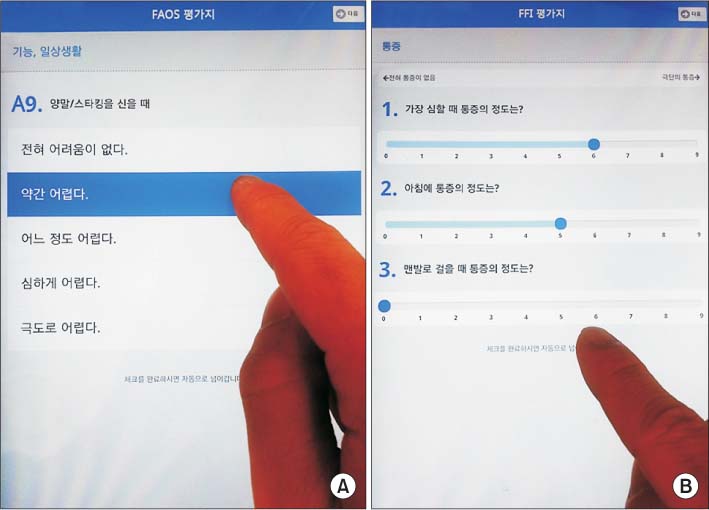J Korean Foot Ankle Soc.
2017 Mar;21(1):33-38. 10.14193/jkfas.2017.21.1.33.
The Methods for Foot Function Index and Foot and Ankle Outcome Score Measurement: A Comparison between Paper-and-Pencil Method and Electronic Method
- Affiliations
-
- 1Seoul Foot and Ankle Center and Department of Orthopaedic Surgery, Seoul Paik Hospital, Inje University College of Medicine, Seoul, Korea. llopiter@naver.com
- KMID: 2371972
- DOI: http://doi.org/10.14193/jkfas.2017.21.1.33
Abstract
- PURPOSE
The patient-reported outcome measure (PROM) is used to quantify the subjective state of patients before and after the treatment. The electronic method was recently developed and used for the completion of PROM, in addition to the conventional paper and pencil method. This study identified whether the results of Foot Function Index (FFI) and Foot and Ankle Outcome Score (FAOS) using the paper and pencil method was different from those using the electronic method.
MATERIALS AND METHODS
Between May 2016 and August 2016, 42 patients who were admitted to the Seoul Foot and Ankle Center two days before surgery were included for evaluation. The mean age was 46 years (range, 21~72 years). There were 29 males and 13 females. To use the electronic method, the PADAS software (PADAS, Seoul, Korea) was implemented using a touch pad. The primary trial of FFI and FAOS was performed using either the paper-and-pencil method or the electronic method. At 24 hours after the primary test, a secondary trial of FFI and FAOS was performed using the other method. Then, we identified the reliability of FFI and FAOS between the two methods by calculating the intraclass coefficient.
RESULTS
Twenty-two patients underwent the first trial using the paper-and-pencil method, and 20 patients underwent the first trial using the electronic method. Of the 42 patients, 8 patients were excluded from this study and only 34 patients were included in this study. The reliability of FFI was excellent with an intraclass coefficient of 0.957, and the reliability of FAOS was also excellent with an intraclass coefficient of 0.840.
CONCLUSION
The paper-and-pencil method and the electronic method have the same result for the completion of FFI and FAOS in this study. Therefore, it is commonly considered that the completion of FFI and FAOS using the electronic method can be applied in practice.
Keyword
Figure
Cited by 1 articles
-
Validation of Electronic Foot Function Index in Patients with Foot and Ankle Disease: A Randomized, Prospective Multicenter Study
Dong Yeon Lee, Yu Mi Kim, Jun Hyung Lee, Jin Kim, Ji-Beom Kim, Bom Soo Kim, Gi Won Choi, Sang Gyo Seo, Jun Beom Kim, Se-Jin Park, Yoon-Chung Kim, Young Rak Choi, Dong-Oh Lee, Jae-Ho Cho, Dong-Il Chun, Hyong Nyun Kim, Jae-Yong Park
J Korean Foot Ankle Soc. 2019;23(1):24-30. doi: 10.14193/jkfas.2019.23.1.24.
Reference
-
1. Deshpande PR, Rajan S, Sudeepthi BL, Abdul Nazir CP. Patient-reported outcomes: a new era in clinical research. Perspect Clin Res. 2011; 2:137–144.
Article2. Button G, Pinney S. A meta-analysis of outcome rating scales in foot and ankle surgery: is there a valid, reliable, and responsive system? Foot Ankle Int. 2004; 25:521–525.
Article3. Boyce MB, Browne JP, Greenhalgh J. The experiences of professionals with using information from patient-reported outcome measures to improve the quality of healthcare: a systematic review of qualitative research. BMJ Qual Saf. 2014; 23:508–518.
Article4. Lane SJ, Heddle NM, Arnold E, Walker I. A review of randomized controlled trials comparing the effectiveness of hand held computers with paper methods for data collection. BMC Med Inform Decis Mak. 2006; 6:23.
Article5. Hung M, Franklin JD, Hon SD, Cheng C, Conrad J, Saltzman CL. Time for a paradigm shift with computerized adaptive testing of general physical function outcomes measurements. Foot Ankle Int. 2014; 35:1–7.
Article6. Gershon RC, Rothrock N, Hanrahan R, Bass M, Cella D. The use of PROMIS and assessment center to deliver patient-reported outcome measures in clinical research. J Appl Meas. 2010; 11:304–314.7. Yaffe M, Goyal N, Kokmeyer D, Merrell GA. The use of an iPad to collect patient-reported functional outcome measures in hand surgery. Hand (N Y). 2015; 10:522–528.
Article8. Lee KM, Chung CY, Kwon SS, Sung KH, Lee SY, Won SH, et al. Transcultural adaptation and testing psychometric properties of the Korean version of the Foot and Ankle Outcome Score (FAOS). Clin Rheumatol. 2013; 32:1443–1450.
Article9. Rosner B. Fundamentals of biostatistics. 7th ed. Boston: Brooks/Cole;2011.10. Budiman-Mak E, Conrad KJ, Roach KE. The foot function index: a measure of foot pain and disability. J Clin Epidemiol. 1991; 44:561–570.
Article11. SooHoo NF, Samimi DB, Vyas RM, Botzler T. Evaluation of the validity of the Foot Function Index in measuring outcomes in patients with foot and ankle disorders. Foot Ankle Int. 2006; 27:38–42.
Article12. Deyo RA, Andersson G, Bombardier C, Cherkin DC, Keller RB, Lee CK, et al. Outcome measures for studying patients with low back pain. Spine (Phila Pa 1976). 1994; 19:18 Suppl. 2032S–2036S.
Article13. Dawson J, Fitzpatrick R, Carr A. Questionnaire on the perceptions of patients about shoulder surgery. J Bone Joint Surg Br. 1996; 78:593–600.
Article
- Full Text Links
- Actions
-
Cited
- CITED
-
- Close
- Share
- Similar articles
-
- Patient-Reported Outcome Measures of the Foot and Ankle
- Comment on "Comparison of Operative Results of Distal Chevron Osteotomy with and without Akin Osteotomy for Moderate to Severe Hallux Valgus"
- Bone Marrow Edema Syndrome of the Foot and Ankle in Adolescents
- Common Foot and Ankle Disease
- Validation of Remote Collection of PatientReported Outcomes Using Patients’ Smartphones



